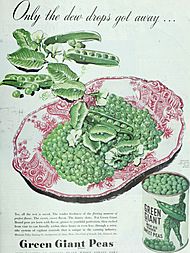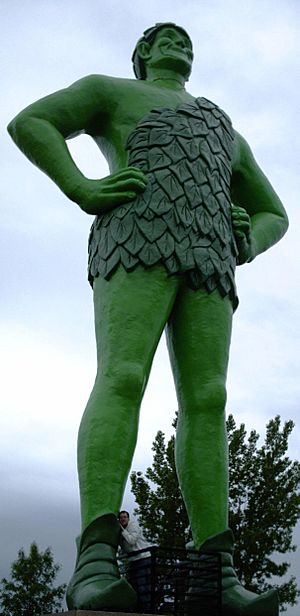Green Giant facts for kids
| Owner | B&G Foods |
|---|---|
| Introduced | 1903 |
| Previous owners | General Mills |
Green Giant is a well-known brand of frozen and canned vegetables. Another brand, Le Sueur (or Le Sieur in Canada), is also part of the company. Both brands are owned by B&G Foods. The company's famous helper is the Jolly Green Giant.
Contents
History of the Green Giant Brand

The company that started it all was called the Minnesota Valley Canning Company. It began in 1903 in Le Sueur, Minnesota. They first sold canned vegetables under the name "Le Sueur Z" in 1903. The name "Le Sueur" by itself started being used in 1933.
The name "Green Giant Great Big Tender Peas" was first used in 1925. Three years later, in 1928, the idea of a giant was added. This happened because a new type of pea was found. These peas were big and wrinkly, but they were also very tender and sweet.
The company decided to sell these special peas under their own name. Instead of hiding the peas' large size, they decided to make it a main point. So, they called the peas "Green Giant." The first giant mascot looked very different from the friendly one we know today. He was a grumpy caveman wearing a bearskin.
In 1935, a writer named Leo Burnett changed the giant's look. He gave the giant a leafy suit and a big smile. He also added the word "Jolly" to the giant's name. The Jolly Green Giant first appeared on TV in 1954. His famous "Ho, ho, ho" sound became his signature in 1961. Since 1972, he has had a young helper named the Little Green Sprout. The Sprout represents the people who buy the products.
The company changed its name to the Green Giant Company in 1950. Later, in 1979, it joined with the Pillsbury Company. In 2001, General Mills bought the group. Then, in 2015, General Mills sold the Green Giant brand to B&G Foods.
In Canada, the brand has been called Le Sieur since at least 1964. This was likely done to avoid confusion with the French word sueur, which means 'sweat'.
In 1999, a top marketing magazine called Advertising Age made a list of the best advertising characters of the 20th century. The Green Giant was ranked third! He was behind the Marlboro Man and Ronald McDonald. This shows how well-known and loved the Green Giant is.
The Valley of the Jolly Green Giant

"The Valley of the Jolly Green Giant" is a nickname for the Minnesota River valley. This area is near Le Sueur. If you drive south on U.S. Route 169, you can see a huge wooden sign. It shows the Jolly Green Giant and the Little Green Sprout. The sign says, "Welcome to the Valley."
About Sixty miles (97 km) further south on US 169, in Blue Earth, Minnesota, there is a giant statue. It is a 55-foot (17 m) tall statue of the Jolly Green Giant made of fiberglass. The statue was first shown in 1978. It was placed on its permanent base on July 6, 1979. More than 10,000 people visit the statue every year.
The idea for the statue came from Paul Hedberg. He owned a local radio station called KBEW. In the summer, he would interview travelers passing through Blue Earth. He often gave them samples of peas and corn from the town's Green Giant canning plant. Many children would ask to "see the Green Giant."
In the late 1970s, the first freeway across the country, Interstate 90, was almost finished. Paul Hedberg wanted to bring more visitors to Blue Earth. He remembered how much kids wanted to see the Green Giant. So, in 1977, he asked the president of Green Giant if they could build a statue. The company agreed, but only if the money was raised locally.
Local businesses quickly raised the $50,000 needed. The four-ton statue was made by Creative Display in Sparta, Wisconsin. It was built in 1978. The Giant's arms were transported separately because he was too wide to fit on a truck. They were attached when the statue arrived in Blue Earth.
The statue stands on a platform with steps. Visitors can stand right under it for a picture. The Jolly Green Giant statue is a famous roadside attraction in America. It has been featured in many magazines. Blue Earth still has a canning plant that used to belong to Green Giant. It continues to can peas and corn each summer.
Blue Earth holds a summer festival called Giant Days. It happens every year after the Fourth of July. In 2014, Paul Hedberg led the parade to celebrate the statue's 35th anniversary. During Giant Days, green footsteps are painted on sidewalks. They lead visitors to local businesses.
Images for kids
-
Jolly Green Giant statue in Blue Earth, Minnesota.
-
An advertisement from 1948 in Ladies' Home Journal.
See also
 In Spanish: Gigante Verde para niños
In Spanish: Gigante Verde para niños



